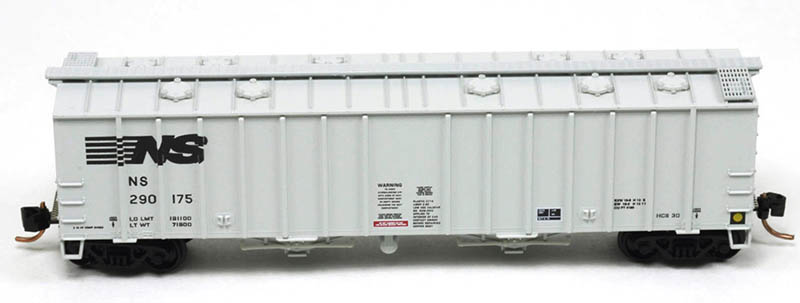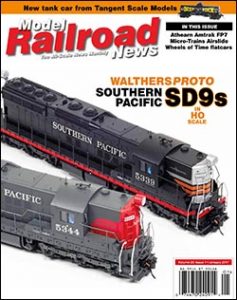 Review by Tony Cook/Photos by the author
Review by Tony Cook/Photos by the author
An all-new freight car recently arrived for Micro-Trains collection of N-scale rolling stock. The model reproduces a very popular General American Airslide hopper car. This 50-foot specialized car came into use on North American railroads in the early 1960s, and you’ll still find Airslides in use today.
The transition from steam locomotives to diesels during and after World War II was a time of significant change and innovation for North American railroads. In addition to a motive power revolution, railroad rolling stock changed too. Freight cars not only started getting longer and heavier, but car builders and railroads also began seeking ways to improve and specialize rolling stock. New prototypes were created that enhanced loading and unloading options or provided conditions that kept cargo more secure or in better environmental conditions inside freight cars. These new freight car styles abounded beginning after the war. The new weight standard of 100 tons spread across car types during the early 1960s. All these factors influenced General American’s 4180 Airslide hopper design introduced in 1963.
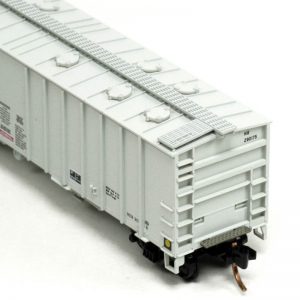
Airslide in N
Micro-Trains selected the most popular example of General American’s larger or 50-foot Airslide hoppers produced beginning in the early 1960s. The car builder’s 4,180-cubic-foot capacity hopper came out in 1963 and saw production through 1980. Larger capacity 4566 and 4895 Airslides followed General American’s introduction of its 100-ton 4180 example; however, these bigger cars didn’t enjoy the same adoption by railroads and private companies operating Airslide fleets.
The earliest 4180 Airslide hoppers included placement of the brake wheel near the roofline. Micro-Trains provides its new N-scale release with a brake wheel situated low in the more modern location. The move for the brake wheel to the lower position is labeled as the TZL production phase in Eric Neubauer’s A History of the General American Airslide and Other Covered Hoppers book. Another change in the production of the prototype saw the outer rib on the car sides go from a thin example to one that was thicker and matched the ribs or exterior-posts running vertically along the sides of the hopper. Micro-Trains includes equal-width ribs on its Airslide hopper, another contributing spotting feature that suggests it matches prototypes produced in the 1970s and later. My estimation of Micro-Trains’ model is that it represents General American’s HC production phase constructed from 1970 to 1980.
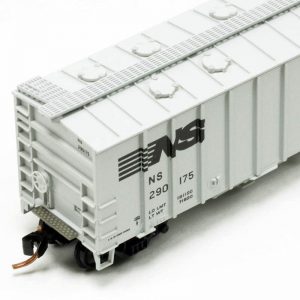 Components of Micro-Trains’ new Airslide hopper include its body shell, 10 separate round roof hatches, brake wheel, and running board. In addition to those plastic pieces, the injection-molded plastic shell includes metal crossover platforms on each end over the coupler areas. The model’s underframe includes body-mounted couplers, separate brake and air details, as well as separate gate pieces for each of the four unloading bays. The cast-metal weight includes indentions to allow it to rest snugly down in the four bays on the underframe’s upper surface. All parts appear to follow Micro-Trains’ snap-fit assembly process with no traces of glue used to secure the model’s numerous pieces.
Components of Micro-Trains’ new Airslide hopper include its body shell, 10 separate round roof hatches, brake wheel, and running board. In addition to those plastic pieces, the injection-molded plastic shell includes metal crossover platforms on each end over the coupler areas. The model’s underframe includes body-mounted couplers, separate brake and air details, as well as separate gate pieces for each of the four unloading bays. The cast-metal weight includes indentions to allow it to rest snugly down in the four bays on the underframe’s upper surface. All parts appear to follow Micro-Trains’ snap-fit assembly process with no traces of glue used to secure the model’s numerous pieces.
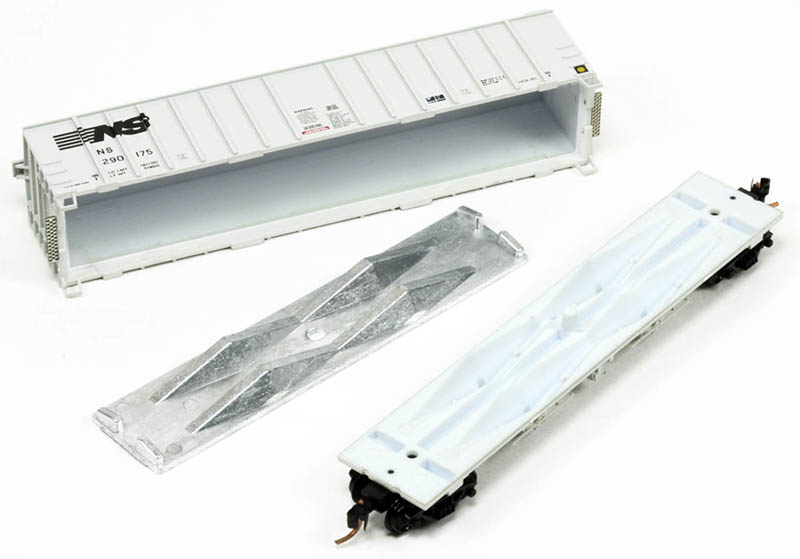
The details provide an excellent scale appearance. You’ll especially appreciate the see-through plastic running boards, roof hatches, and underframe bay gates or doors. I had to look twice at the fine-scale ladders. I mistook the ladders for separately applied parts at first. The only detail part that I wasn’t greatly impressed with was the etched metal end platforms. Left in what appears to be the raw metal state, I thought the crossover platforms could use some paint attention. I also felt the round holes looked a bit large in diameter. A touch of paint or weathering coloring would subdue this area into a better-looking section for this otherwise excellent effort.
Comparing this new N-scale model with a diagram included in Eric Neubauer’s Airslide book, I found Micro-Trains’ effort came out to the desired 50-foot, 9-inches length. Also matching the prototype dimensions were the measurements along the unloading bays and the 40-foot, 9-inch distance between the centers of the axles.
The new Airslide hopper model weighs in at 1.05 ounces. In comparison, Micro-Trains 50-foot boxcar sample measured the same 1.05 ounces, and the manufacturer’s slightly longer 54-foot CenterFlow hopper weighed 1.15 ounces. As noted, Micro-Trains includes body-mounted knuckle couplers on its new Airslide hopper model. Most operators and even collectors will agree this is a welcome attribute. This model checked out when coupled to Micro-Trains’ Coupler Height Gauge (#98800031, MSRP: $9.60).
The model performed without issue navigating 9.75-inch radius curves and rolling across No. 6 turnouts. The inclusion of body-mounted couplers allows for better operation when a locomotive is pushing a car into a siding. Couplers mounted to trucks tend to wander to the left or right during back-up moves, and this can cause a derail. For the collector, I think you’ll agree, models simply look better and provide a more realistic appearance with body-mounted couplers. This new N-scale Airlside hopper model rides on plastic roller bearing truck sideframes with plastic wheels.

The road numbers, 290175 and 290176, on Micro-Trains’ Norfolk Southern examples and the inclusion of “HCS 30” classification appears to closely match the decoration of prototypes observed during my research of this release. Norfolk Southern predecessor roads Norfolk & Western and Southern Railway owned 4180 Airslides. Norfolk & Western’s roster included what appears to be a single group of 50 Airslides bought in the mid-1960s of TZH production phase design. Southern Railway owned a variety of 4180s from early HAT production models through late 1970s HC examples. Southern’s 4180 Airslide collection totaled approximately 300. These Micro-Trains Norfolk Southern Airslide hopper models represent original Southern Railway cars (90170– 90194) bought in 1967.
Conclusion
N-scale modelers and collectors will no doubt see many more releases from Micro-Trains for this impressive reproduction of a very familiar hopper car prototype. If you’re curious about General American’s Airslide hopper history, you can find Eric Neubauer’s book, as well as his other efforts, listed on his website. At the time of this review, in addition to the 1980s painted Norfolk Southern, Micro-Trains released a light blue Airslide with GACX reporting marks. This model, available in two road numbers, includes a dark blue band on the car’s left side with yellow GATX Airlside labeling and sells for $29.75. The road numbers employed on the pair of GATX Airslide releases fall into a group of hopper cars built in 1978 for grain-processing service.
50-foot Airslide hopper car
Norfolk Southern #09800021
MSRP: $27.95
Micro-Trains Line Co.
P.O. Box 1200
Talent, OR 97540-1200
541-535-1755


